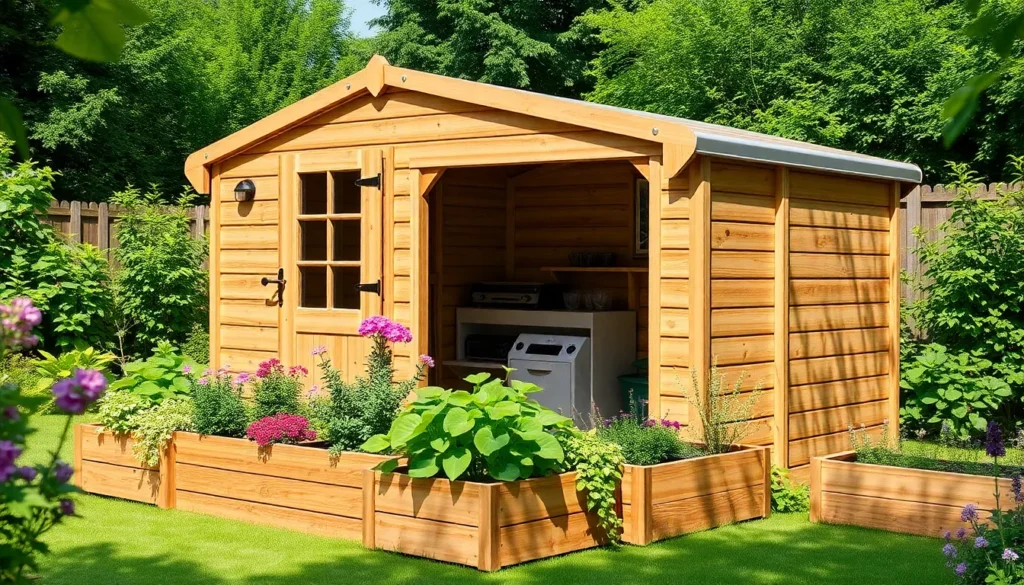In a world where plastic seems to multiply faster than rabbits, sustainable living isn’t just a trend—it’s a necessity. Imagine a life where your morning coffee doesn’t come with a side of guilt and where eco-friendly choices become second nature. It’s not about becoming a tree-hugging hermit; it’s about making smart choices that benefit both the planet and your wallet.
This sustainable living guide is here to help anyone navigate the wild jungle of eco-consciousness without losing their sense of humor. From quirky tips to practical advice, it shows how easy—and fun—it can be to embrace a greener lifestyle. So grab your reusable shopping bag and let’s dive into the delightful world of sustainable living, where saving the planet can be as enjoyable as binge-watching your favorite series.
Table of Contents
ToggleUnderstanding Sustainable Living
Sustainable living involves making choices that meet present needs without compromising future generations. It focuses on reducing ecological footprints through eco-friendly practices.
Definition of Sustainable Living
Sustainable living refers to a lifestyle that minimizes an individual’s or society’s use of natural resources. This definition includes practices such as reducing waste, conserving energy, and choosing renewable resources. Individuals engage in sustainable living by prioritizing local, organic foods and employing energy-efficient appliances. These habits help reduce pollution and conserve biodiversity, contributing to a healthier planet.
Importance of Sustainability
Sustainability holds immense importance for the environment and society. It addresses issues such as climate change, resource depletion, and waste management. By adopting sustainable practices, communities can promote economic growth while preserving natural ecosystems. Research indicates that sustainable living reduces greenhouse gas emissions and enhances overall quality of life. People who adopt these practices often discover financial savings, as resource-efficient habits cut utility costs and decrease waste. Emphasizing sustainability contributes to a more resilient future for all.
Key Principles of Sustainable Living
Sustainable living promotes eco-friendly practices that prioritize the environment. Key principles focus on reducing waste, using resources wisely, and making responsible choices.
Reduce, Reuse, Recycle
Reducing waste starts with mindful consumption. Individuals cut back on single-use items, significantly lowering plastic waste. Reusing materials extends their life span, keeping them out of landfills. Creative re-purposing can turn old items into useful objects. Recycling products ensures valuable materials are processed and reintegrated into new items. Communities play a crucial role in providing recycling programs to encourage participation.
Sustainable Products and Practices
Choosing sustainable products makes a tangible difference. Opting for organic food reduces chemical usage and promotes healthier ecosystems. Purchasing energy-efficient appliances conserves energy and lowers utility bills. In the area of transportation, embracing public transit options leads to fewer carbon emissions. Supporting local businesses strengthens community ties while reducing transportation-related carbon footprints. Mindfulness in daily practices fosters a lifestyle that respects natural resources, ensuring a balanced future.
Creating a Sustainable Home
Creating a sustainable home involves making smart choices that enhance energy and resource efficiency. This transformation can significantly reduce one’s ecological footprint.
Energy Efficiency
Utilizing energy-efficient appliances is a primary step towards sustainability. LED light bulbs consume up to 75% less energy than traditional incandescent bulbs. Insulating homes properly minimizes heating and cooling costs, ensuring comfort with reduced energy consumption. Installing smart thermostats allows for optimized heating schedules. When necessary, consider renewable energy sources like solar panels to generate clean electricity.
Water Conservation
Implementing water-saving fixtures is essential for conservation efforts. Low-flow showerheads can reduce water usage by approximately 50%. Fixing leaks promptly prevents significant water wastage over time. Collecting rainwater for outdoor use helps maintain gardens effectively while conserving municipal resources. Choosing drought-resistant plants for landscaping minimizes irrigation needs.
Eco-Friendly Materials
Incorporating eco-friendly materials promotes sustainability in home construction and decor. Bamboo flooring offers a renewable option due to its rapid growth rate. Reclaimed wood adds unique character while reducing the demand for new lumber. Non-toxic paints and finishes contribute to better indoor air quality and health. Using recycled materials for construction reduces waste and supports a circular economy.
Sustainable Eating Habits
Sustainable eating habits significantly contribute to a greener lifestyle by minimizing environmental impact. Two foundational elements in this pursuit are plant-based diets and local seasonal foods.
Plant-Based Diets
Plant-based diets emphasize the consumption of fruits, vegetables, grains, legumes, nuts, and seeds. Adopting these diets reduces reliance on animal products, which generally require more resources to produce. Research shows that plant-based meals can cut individual carbon footprints by up to 50% compared to diets high in meat. Additionally, sourcing ingredients from local farmers markets or organic farms supports community agriculture while ensuring fresher options. Focusing on whole foods leads to better health and less processed waste. Eating more plant-based options also encourages diversity in food choices and nutrition.
Local and Seasonal Foods
Choosing local and seasonal foods enhances sustainability while promoting environmental health. Buying food grown within a 100-mile radius sharply reduces transportation emissions, keeping food fresher and supporting local economies. Seasonal produce often provides maximum flavor and nutrient density, making meals healthier and more enjoyable. Engaging with local farmers fosters community connection and shared knowledge about sustainable practices. Individuals can explore new recipes around seasonal harvests, which helps diversify their diets and reduce reliance on out-of-season imports. Emphasizing local and seasonal choices aligns consumption with ecological rhythms, ultimately benefiting both individuals and the environment.
Alternative Transportation Options
Exploring alternative transportation options significantly reduces carbon footprints and enhances community connections. Choosing methods that minimize resource use promotes a sustainable lifestyle.
Public Transit and Carpooling
Utilizing public transit options, such as buses and trains, reduces the number of individual vehicles on the road. These systems often run on renewable energy, making them a cleaner choice for travel. Sharing rides through carpooling further lowers emissions, as fewer cars traverse the same route. This practice not only saves on fuel costs but also fosters social interaction among commuters. Supporting efficient public transit networks leads to less congestion and a healthier environment.
Biking and Walking
Opting to bike or walk encourages an active lifestyle while cutting down on fossil fuel use. These modes of transportation produce zero emissions and improve air quality within urban areas. Cycling offers both health benefits and economic savings, as less money goes towards gas and vehicle maintenance. Walking promotes community engagement, allowing individuals to explore their neighborhoods at a leisurely pace. Incorporating biking or walking into daily routines contributes positively to personal well-being and environmental sustainability.
Community Involvement
Community involvement strengthens sustainable living efforts while building connections. Engaging with local initiatives fosters collective action toward environmental goals.
Local Initiatives
Participation in community programs enhances sustainable practices. Local gardens or co-ops provide fresh produce while minimizing food miles. Neighborhood clean-up events effectively reduce litter and promote awareness of waste management. Many towns host sustainability workshops that teach eco-friendly skills, from composting to energy-efficient home improvements. Supporting local businesses, including farmer’s markets, boosts the economy and encourages sustainable sourcing. Collaborating on community projects not only protects the environment but also cultivates a sense of belonging and purpose.
Volunteering and Advocacy
Volunteering amplifies sustainable living messages. Many organizations offer opportunities to assist with environmental preservation efforts. Joining advocacy groups strengthens the push for policy changes that support sustainability initiatives. Participation in local government meetings gives individuals a voice in planning for green spaces and eco-friendly development. Engaging in educational campaigns raises awareness and empowers others to adopt sustainable practices. Actively getting involved in advocacy not only drives change but also inspires a shared commitment to protecting the planet.
Embracing sustainable living is more than just a trend; it’s a necessary shift toward a healthier planet. By adopting eco-friendly practices and making conscious choices, individuals can significantly reduce their ecological footprints while enjoying the process.
Every small action contributes to a larger movement that prioritizes environmental wellbeing and community engagement. Through mindful consumption and active participation in local initiatives, people can inspire others and foster a culture of sustainability.
Ultimately, the journey toward sustainable living is a collective effort that not only benefits the environment but also enhances personal quality of life. As more individuals commit to these principles, the vision of a greener future becomes increasingly attainable.










